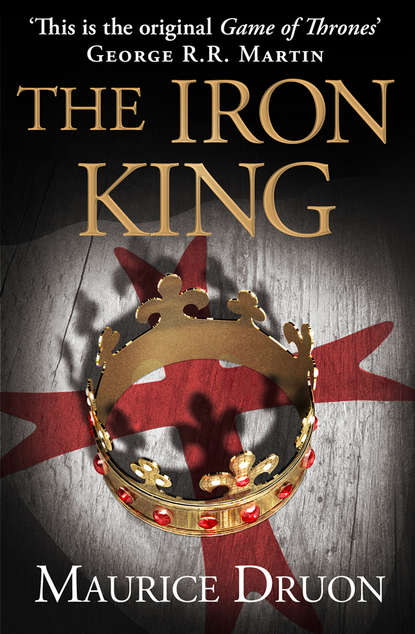По всем вопросам обращайтесь на: info@litportal.ru
(©) 2003-2024.
✖
The Iron King
Автор
Год написания книги
2019
Настройки чтения
Размер шрифта
Высота строк
Поля
JEANNE OF BURGUNDY, aged about 21, daughter of the Count Palatine of Burgundy, wife to Philippe.
BLANCHE OF BURGUNDY, her sister, aged about 18, wife to Charles.
HIS MINISTERS AND JUSTICIARS:
ENGUERRAND LE PORTIER DE MARIGNY, aged 52, Coadjutor and Rector of the Kingdom.
GUILLAUME DE NOGARET, aged 54, Keeper of the Seals and Secretary-General of the Kingdom.
HUGUES DE BOUVILLE, Grand Chamberlain.
THE ARTOIS BRANCH, DESCENDED FROM A BROTHER OF SAINT LOUIS:
ROBERT III OF ARTOIS, Lord of Conches, Count of Beaumont-le-Roger, aged 27.
MAHAUT, his aunt, aged about 40, widow of the Count Palatine of Burgundy, Countess of Artois, a peer of France, mother of Jeanne and Blanche of Burgundy and cousin of Marguerite of Burgundy.
THE TEMPLARS:
JACQUES DE MOLAY, aged 71, Grand Master of the Order of Knights Templar.
GEOFFROY DE CHARNEY, Preceptor of Normandy.
EVERARD, one-time Knight of the Order of Templars.
THE LOMBARDS:
SPINELLO TOLOMEI, a Siennese banker living in Paris.
GUCCIO BAGLIONI, his nephew, aged about 18.
THE BROTHERS AUNAY:
GAUTIER, son of the Chevalier d’Aunay, aged about 23, Equerry to the Count of Poitiers.
PHILIPPE, his brother, aged about 21, Equerry to the Count of Valois.
THE CRESSAY FAMILY:
DAME ELIABEL, widow of the Squire of Cressay, aged about 40.
PIERRE AND JEAN, her sons, aged 20 and 22.
MARIE, her daughter, aged 16.
AND THESE:
JEAN DE MARIGNY, Archbishop of Sens, younger brother of Enguerrand de Marigny.
BEATRICE D’HIRSON, first lady-in-waiting to the Countess Mahaut, aged about 20.
The Iron King (#ulink_9e874839-9808-502e-ae17-6989aa8269ba)
The Grand Master felt surging within him one of those half-crazy rages which had so often come upon him in his prison, making him shout aloud and beat the walls. He felt that he was upon the point of committing some violent and terrible act – he did not know exactly what – but he felt the impulse to do something.
He accepted death almost as a deliverance, but he could not accept an unjust death, nor dying dishonoured. Accustomed through long years to war, he felt it stir for the last time in his old veins. He longed to die fighting.
He sought the hand of Geoffroy de Charnay, his old companion in arms, the last strong man still standing at his side, and clasped it tightly.
Raising his eyes, the Preceptor saw the arteries beating upon the sunken temples of the Grand Master. They quivered like blue snakes.
The procession reached the Bridge of Notre-Dame.
Prologue (#ulink_80df7833-d9b5-5b97-947d-fe9ca7d7af0f)
At the beginning of the fourteenth century, Philip IV, a king of legendary personal beauty, reigned over France as absolute master. He had defeated the warrior pride of the great barons, the rebellious Flemings, the English in Aquitaine, and even the Papacy which he had proceeded to install at Avignon. Parliaments obeyed his orders and councils were in his pay.
He had three adult sons to ensure his line. His daughter was married to King Edward II of England. He numbered six other kings among his vassals, and the web of his alliances extended as far as Russia.
He left no source of wealth untapped. He had in turn taxed the riches of the Church, despoiled the Jews, and made extortionate demands from the community of Lombard bankers. To meet the needs of the Treasury he debased the coinage. From day to day the gold piece weighed less and was worth more. Taxes were crushing: the police multiplied. Economic crises led to ruin and famine which, in turn, caused uprisings which were bloodily put down. Rioting ended upon the forks of the gibbet. Everyone must accept the royal authority and obey it or be broken by it.
This cruel and dispassionate prince was concerned with the ideal of the nation. Under his reign France was great and the French wretched.
One power alone had dared stand up to him: the Sovereign Order of the Knights Templar. This huge organisation, at once military, religious and commercial, had acquired its fame and its wealth from the Crusades.
Philip the Fair was concerned at the Templars’ independence, while their immense wealth excited his greed. He brought against them the greatest prosecution in recorded history, since there were nearly fifteen thousand accused. It lasted seven years, and during its course every possible infamy was committed.
This story begins at the end of the seventh year.
PART ONE (#ulink_58fa9a5e-c0d4-584b-89bc-33eeac1019de)
A CURSE (#ulink_58fa9a5e-c0d4-584b-89bc-33eeac1019de)
1 (#ulink_d37b244e-66c5-5140-b5bd-3daca57cbaed)
The Loveless Queen (#ulink_d37b244e-66c5-5140-b5bd-3daca57cbaed)
A HUGE LOG, LYING UPON a bed of red-hot embers, flamed in the fireplace. The green, leaded panes of the windows permitted the pale light of a March day to filter into the room.
Sitting upon a high oaken chair, its back surmounted by the three lions of England, her chin cupped in her hand, her feet resting upon a red cushion, Queen Isabella, wife of Edward II, gazed vaguely, unseeingly, at the glow in the hearth.
She was twenty-two years old, her complexion clear, pretty and without blemish. She wore her golden hair coiled in two long tresses upon each side of her face like the handles of an amphora.
She was listening to one of her French Ladies reading a poem of Duke William of Aquitaine.
D’amour ne dois-je plus dire de bien
Car je n’en ai ni peu ni rien,

















